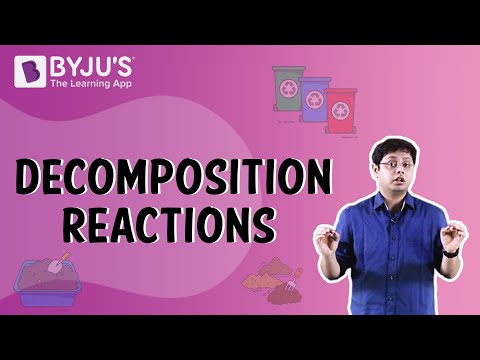When chemical bonds between atoms are formed or broken, chemical reactions occur. The substances that are introduced into a chemical reaction are known as reactants, and the substances that are produced at the end of the reaction are known as products. To indicate the direction of the chemical reaction, an arrow is drawn between the reactants and products.
| Definition: A chemical reaction occurs when the bonds between reactant molecules are broken and new bonds are formed between product molecules to form a new substance.
Chemical reactions can be found all around us, from the metabolism of food in our bodies to the light we receive from the sun. |
Chemical Reactions Chemistry Questions with Solutions
Q1. On immersing an iron nail in CuSO4 solution for a few minutes, you will observe-
- No reaction takes place
- The colour of the solution fades away
- The surface of iron nails acquires a black coating
- The colour of the solution changes to green
Correct Answer. (d)
Explanation: Due to their high reactivity, iron ions gradually displace the copper ions that make up their solution. Due to the displacement reaction, iron ions undergo a mixed solution while copper ions are deposited on iron nails. When we immerse iron nails in the CuSO4 solution, we will notice a colour shift from blue to green, as well as a brown deposit on the iron nails.
Q2. Respiration is an:
- exothermic reaction.
- endothermic reaction.
- Both (a) and (b).
- None of these.
Correct Answer. (a) exothermic reaction
Explanation: Respiration is an exothermic reaction because energy is released during this process.
Q3. What happens when dilute hydrochloric acid is added to iron filings?
- Hydrogen gas and iron chloride are produced.
- Chlorine gas and iron hydroxide are produced.
- No reaction takes place.
- Iron salt and water are produced.
Correct Answer. (a) Hydrogen gas and iron chloride are produced.
Q4. Chlorine gas is passed in an aqueous potassium iodide solution to form potassium chloride solution and solid iodine. Identify the type of reaction:
- Decomposition reaction
- Double Displacement reaction
- Displacement reaction
- None of these
Correct Answer. (c) Displacement reaction
Q5. Name two metals that don’t get corroded.
Answer. Gold (Au) and platinum (Pt) do not get corroded.
Q6. Identify the most reactive and least reactive metals: Al, K, Ca, Au.
Answer: Most reactive metal: K (potassium), Least reactive metal: Au (gold).
Q7. Identify the substance oxidised and reduced in the reaction:
Zn + CuO → ZnO + Cu
Answer. Zinc is oxidised to zinc oxide and copper oxide is reduced to copper.
Q8. What is rust?
Answer. Rust is the name given to the red iron oxides formed when ferrous metals corrode. The chemicals formed when iron reacts with oxygen and water are known as rust. It has the formula Fe2O3.xH2O.
Q9. Define precipitate.
Answer. The precipitate is the insoluble solid that settles after the chemical reaction is complete. The precipitate’s formation can aid in determining the presence of various types of ions or atoms.
Q10. Why does not a wall immediately acquire a white colour when a coating of slaked lime is applied to it?
Answer. Slaked lime is not particularly white. When CO2 gas from the air is applied to the wall, it reacts with calcium hydroxide to form calcium carbonate. It is completely white and thus gives the wall a white appearance.
Ca(OH)2 + CO2 (g) → CaCO3 (s) + H2O (l)
Q11. Give reasons:
- Why is a combustion reaction an oxidation reaction?
- Why does not silver evolve hydrogen on reacting with dilute sulphuric acid?
Answer.
1. Since combustion reactions are always carried out in the presence of air or oxygen, they are oxidation reactions. As an example,
CH4 + 2O2 → CO2 +2H2O
2. Silver is a less reactive metal in the sense that it ranks lower in the reactivity series than hydrogen. As a result, it does not produce hydrogen gas when reacting with dilute sulphuric acid or dilute hydrochloric acid.
Q12. Answer the following:
- What is observed when a solution of potassium iodide is added to a solution of lead nitrate taken in a test tube?
- What type of reaction is this?
- Write a balanced equation to represent the above reaction.
Answer.
- A yellow precipitate of lead iodide appears at the bottom of the test tube.
- It is an example of a double displacement reaction.
- The balanced equation for the reaction is-
Pb(NO) (aq) + 2KI (aq) → PbI (s) + 2KNO3 (aq)
Q13. What happens when an aqueous solution of sodium sulphate reacts with an aqueous solution of barium chloride? State the physical conditions of reactants in which the reaction between them will not take place. Write the balanced chemical equation for the reaction and name the type of reaction.
Answer. When the two aqueous solutions of sodium sulphate and barium chloride are mixed in a test tube, a white precipitate of barium sulphate forms immediately. If the two reactants are solid, no reaction can take place. For the double displacement reaction, the balanced chemical equation is:
BaCl2 (aq) + Na2SO4 (aq) → BaSO4 (s) + 2NaCl (aq)
Q14. Select (i) combination reactions (ii) decomposition reactions and displacement reactions from the following-
- ZnCO3 → ZnO + CO2
- Pb + CuCl2 → PbCl2 + Cu
- H2 + Cl2 → 2HCl
- Fe2O3 + 2Al → Al2O3 + 2Fe
- 3H2 +N2 → 2NH3
Answer.
- Decomposition reaction
- Displacement reaction
- Combination reaction
- Displacement reaction
- Combination reaction
Q15. Account for the following-
- Why cannot a chemical change be normally reversed?
- Why is it always essential to balance a chemical equation?
- Why do diamond and graphite, the two allotrope forms of carbon evolve different amounts of heat on combustion?
- Can rusting of iron take place in distilled water?
Answer.
- The products of a chemical reaction differ greatly from the reactants. As a result, it cannot normally be reversed.
- To satisfy the law of conservation of mass, a chemical equation must be balanced. The total mass of the reacting species participating in the reaction is equal to the total mass of the products formed, according to the law. Since there is a direct relationship between the mass of different species and their number, a chemical equation must always be balanced.
- Since they have different shapes and differ in the arrangement of carbon atoms. The attractive forces between the atoms are not the same in both cases. As a result, they produce varying amounts of heat.
C(diamond) + O (g) → CO2 (g) + 393.5 KJ
C(graphite) + O2 (g) → CO2 (g) + 395 KJ
4. No, iron cannot rust in distilled water because it contains neither dissolved oxygen nor carbon dioxide. Both are required for iron to rust.
Practise Questions on Chemical Reactions
Q1. Identify the substance oxidised and substance reduced in the following reactions-
(i) ZnO(s) + C(s) → Zn(s) + CO(g)
(ii) 2Na(s) + O2(g) → 2Na2O(s)
(iii) CuO(s) + H2(g) → Cu(s) + H2O(l).
Q2. Which types of reactions are represented by the following equations?
- CaO + CO2 → CaCO3
- Mg + CuSO4 → MgSO4 + Cu
- CH4 + 2O2 → CO2 + 2H2O
- NH4NO2 → N2 + 2H2O.
Q3. What happens when CO2(g) is bubbled through lime water-
- in a small amount
- in excess
Q4. Why is silver bromide stored in dark bottles in the laboratories? Write the chemical equation to justify your answer.
Q5. Write balanced chemical equations for the following reactions:
- dilute sulphuric acid reacts with aluminium powder
- dilute hydrochloric acid reacts with sodium carbonate
- Carbon dioxide is passed through lime water.
Click the PDF to check the answers for Practice Questions.
Download PDF
Recommended Videos
Decomposition Reaction

General Chemical Reactions

Comments